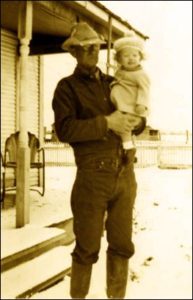
Although not as cold as the winter of 1899, it was a snowy day when this picture of my grandfather and me was taken.
WOOSH! It’s cold outside. Words from my childhood I absolutely detested. There were never enough sweaters, mittens, boots, stocking caps, or hot chocolate to keep me warm. I still feel the same way and still live within a hundred miles of my childhood home. It’s cold outside today. And here in Texas we haven’t experienced the weather the East Coast and New England have.
But as a historian I think about what life was like a century ago, or even during the Great Depression. What about those poor soldiers on both sides in Germany or Korea who were out in the cold? The list could go on and on.
You get the picture, we’ve all heard about the brutal cold weather. Yet on February 12, 1899 “The Big Freeze” hit the entire country. An arctic blast sent temperatures across Texas diving to records that have yet to be broken. The coldest temperature ever recorded in Texas was minus 23 degrees that night in Tulia, on the High Plains. The same record was matched in Seminole, Texas on February 8, 1933.
Blizzard conditions paralyzed the East Coast, as bad as the storms this month. No snow in Chicago allowed the ground to freeze down five feet, causing unimaginable damage to pipes. For only the second time in recorded history, the Mississippi River carried ice into the Gulf of Mexico. Galveston Bay reported a thin layer of ice. The cold weather was blamed for the deaths of 105 people in the nation, fifteen here in Texas.
Yes, the death rates were lower than this year, but remember there were no automobiles on the non-existent roads. There were no television crews to stand on the side of the road freezing while filming the disaster for others sitting in snug homes watching on TV.
One of my grandfathers was about seven years old during that blizzard. His family lived on a cattle ranch in Montague County near the Red River. The river froze in places. When a freeze hit, all available hands headed to waterholes to break the ice for cattle and horses. My grandfather remembered that his job was to keep the water troughs in the feedlots clear of ice for any livestock around the house.
Livestock are pretty smart, though. Instinctively they turned south, away from the freezing north wind. Slowly they moved southward searching shelter. If they arrived at a fenced corner with no exit, they continued moving. The weaker animals were then trampled. So it was and still is the responsibility of cowhands to steer them to some shelter.
In towns and on farms, the houses were not built as well as they are today. No insulation, no central heat, no thermal windows, just space around doors and windows for the sharp north wind to get in. Some families pasted newspapers on the walls, but with little success. Most families shut off the extra rooms, gathered in a room on the south side of the house and huddle in front of the fireplace or wood stove.
But the fireplaces or wood stoves were dangerous. House fires were frequent, leaving families stranded with no warm clothing. Everyone welcomed the sunshine and temperatures above freezing. And in 1899 few forgot those bitterly cold days.
